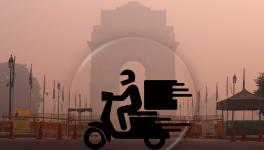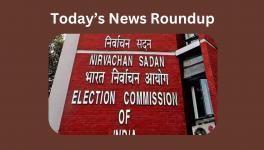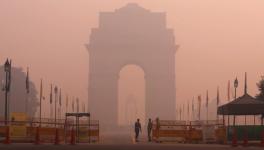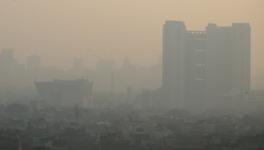Killer Delhi Air Reminds, Pollution Needs National Solution
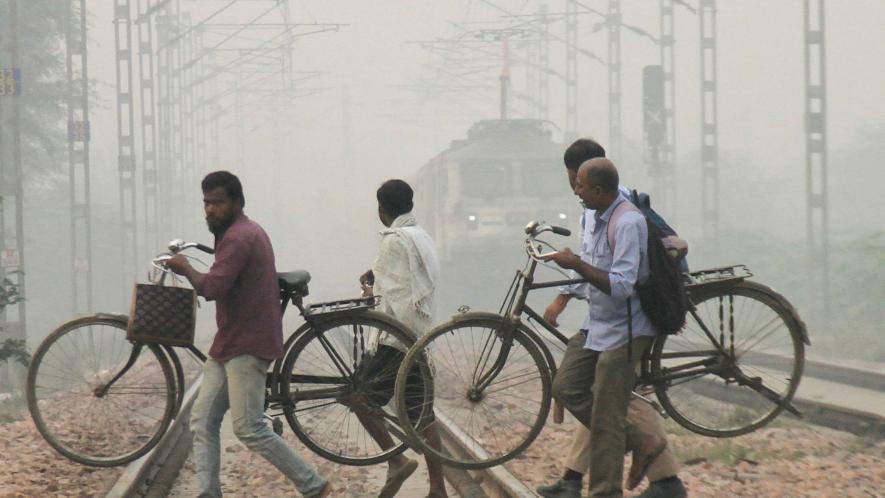
Commuters cross railway tracks amid low visibility due to smog, in Gurugram, Thursday, Nov. 9, 2023. Image Courtesy: PTI
Delhi’s air quality worsens every Diwali season, and this year is no exception. The rainfall in parts of the National Capital Region (NCR) brings some relief, but will hardly change things unless the rainfall is widespread and prolonged—which will have other negative consequences for the economy and people. Hence, Delhi and its surroundings, with the air quality index hitting 500, 100 times above what the World Health Organization (WHO) has deemed healthy, needs to be part of a national solution for the pollution crisis.
The 3.3 crore people living in the NCR are only too aware that the cold-weather smog sees the PM2.5 levels register a dangerous 100% increase, piercing the lungs of citizens and precipitating a host of diseases. On November 2 alone, they recorded a 68% increase in 24 hours. Similar statistics emerged from around the country, making people worried about what miseries the expected spike in pollution with Diwali cracker-burning will bring.
The weary citizens, and especially the elderly and young of this mega city, are asking why the central and state governments, including those of Delhi, Punjab, Haryana and Uttar Pradesh, have failed to get together and draw up a game-plan that will resolve this annual catastrophe that afflicts all? They know that blaming seasonal factors like crop-residue burning and festival-related pollution is not the answer.
However, the seriousness of this matter seems lost on our decision-makers. A few years ago, Dr Arvind Kumar, who headed the Lung Care Foundation at Sir Ganga Ram Hospital, recreated a pair of large human lungs with the help of HEPA (High-efficiency Particulate Air) filters, which are used to trap dust in operation theatres. These “lungs’ were designed to mimic the workings of a pair of human lungs. Dr Kumar had expected the lungs to become dark (signifying high pollution) over time, but they started to darken in just one day and went utterly dark within six days. Dr Kumar said, speaking not only about the effects of pollution in the capital and the entire country, “There are no non-smokers left in India. We have become a nation of smokers.”
The point Dr Kumar was trying to make was that in Delhi, to cite an example, the PM 2.5 levels are high around the year, with doctors insisting this toxic air is the equivalent of smoking over ten cigarettes a day, even for newborn children. With air pollution levels having risen alarmingly across all the major cities of the Indo-Gangetic plain, the situation has become alarming throughout the country.
“This is a failure on the part of individuals, officials, organisations to take cognisance of the fact that breathing is killing [us],” he said in a widely-circulated interview.
Dr Piyush Ranjan from the Department of Medicine AIIMS recently warned, “Air pollution affects various systems of the body apart from causing respiratory diseases. Pollution has direct relations with coronary artery diseases like heart attack, brain stroke and arthritis, and there is scientific evidence to show its relationship with different types of cancer.”
Delhi has set up a Commission for Air Quality Management (CAQM), a statutory body responsible for strategies to combat pollution. It has prepared a graded response plan, and the Grade 4 response has kicked in under the present circumstances. The CAQM has banned diesel BS-4 and all BS-3 private cars and banned diesel-run medium goods vehicles and heavy goods vehicles in the city. But despite a ban on construction activities and the closure of schools until November 26, the ambient air quality has not improved. This is because the root of the problem is not being addressed.
The political class does a great deal of name-calling, with each blaming this mess on the rival party. The Bharatiya Janata Party and the Congress are pointing fingers at the Aam Aadmi Party government in Delhi, blaming it for the present situation given that farm fires are spiking in Punjab. Indeed, reports of these fires continue to come in despite the Supreme Court ordering the Punjab and Haryana governments to ensure farmers stop burning stubble in their fields.
Can AAP escape blame for the crisis in Delhi? According to the Bharatiya Janata Party, the party has failed to provide alternatives to the farmers, resulting in farm fires. Priyanka Kakkar, a party spokesperson, defended her party and called the criticism baseless as she believes Chief Minister Arvind Kejriwal has taken steps to clear Delhi’s air. This includes introducing electric buses, stopping waste burning, and ensuring all industries run on CNG.
According to Kakkar, there were 81,000 farm fires in Punjab in 2016 and only 19,000 in 2023. However, this is contradicted by NASA figures, which paint a very different picture.
She says ensuring 24x7 electricity supply reduced diesel generator use in the capital, unlike Uttar Pradesh and Haryana, where power cuts force industry and housing societies to use diesel generators.
Herein lies the crux of the problem. While there is no doubt that the farm fires helped accelerate the crisis, several neighbouring cities including Ghaziabad, NOIDA, Greater NOIDA and Faridabad report highly hazardous air. According to the Central Pollution Control Board data for the first week of November, Greater NOIDA has the dubious distinction of being the country’s most polluted city. Meanwhile, last year, the World Air Quality Report ranked Delhi the fourth most polluted of 50 cities in the world. This year, Delhi is in an equally bad, if not worse, situation.
How, then, should our planners bring about a turnaround? How should PM 2.5 levels be immediately reduced by 60% to meet the National Ambient Air Quality standards? For one, they must recognise the different sources causing 24/7 pollution around the year. However, the government must also ensure a significant transition from private vehicles to public transport use. In New York and London, exorbitant parking fees have made even the wealthy feel the pinch of driving personal cars and two-wheelers.
By contrast, 1.2 crore vehicles in Delhi were recorded as registered in 2020, though this dipped in the following year. Still, the number of vehicles plying in Delhi on any day exceeds the registered vehicles figure because of cabs from neighbouring cities (which are banned now). Further, trucks and buses using BS 3 diesel supply essential commodities to the city. The government will have to introduce strict laws and restrictions to control private vehicles, but this will only work if there is efficient, reliable and inexpensive last-mile connectivity for public transport, especially the Delhi Metro and bus services.
By and large, industries in Delhi have switched to CNG, but the government needs to take adequate steps to ensure that CNG remains a viable option against the price of coal. If not, people will rely on coal, whatever the environmental consequences.
The other major problem in Delhi is waste management. The CPCB’s annual report for waste management in 2021 revealed that Delhi had the highest per-capita waste generation (450 grams per day), while 263 tonnes of solid waste was generated daily, which is unaccounted for. This is because a lot of trash has been outsourced to private players and is not handled by municipal corporations.
Delhi’s waste-to-energy plants also need to be more efficient. For every tonne of burnt waste, 300 kg of trash is dumped in landfills.
Anumita Roychowdhury, executive director of the Centre for Science and Environment, says, “The states and Centre need to act on a massive scale and with rapid speed to fill some glaring gaps in policy. They must realise that transportation remains the biggest polluter in Delhi, much more than farmers’ fires. The 1.2 crore vehicles plying in the capital add to the traffic congestion on the streets. The government needs to follow a regional approach to resolve this issue, a Delhi-centric approach alone will not work.”
Medical experts say that all sections of society, including politicians, religious leaders and others, must join hands. As Dr Kumar has said, he tried to engage with spiritual figures so they could tell followers what steps to take to curb pollution. Sadly, he claims, he met with little success.
The government continues to be one of the biggest polluters in the NCR, given the number of building projects being undertaken by the Centre. Dust and smoke remain two of the biggest polluters, which can only be curbed if all non-essential construction stops immediately.
Pollution is a deadly killer, and it is questionable how ‘slow’ it is in claiming victims, for India has had unacceptably poor air quality for well over a decade. Unfortunately, governments are blind to the consequences and the toll it has been taking on the country’s entire population.
The author is an independent journalist. The views are personal.
Get the latest reports & analysis with people's perspective on Protests, movements & deep analytical videos, discussions of the current affairs in your Telegram app. Subscribe to NewsClick's Telegram channel & get Real-Time updates on stories, as they get published on our website.














